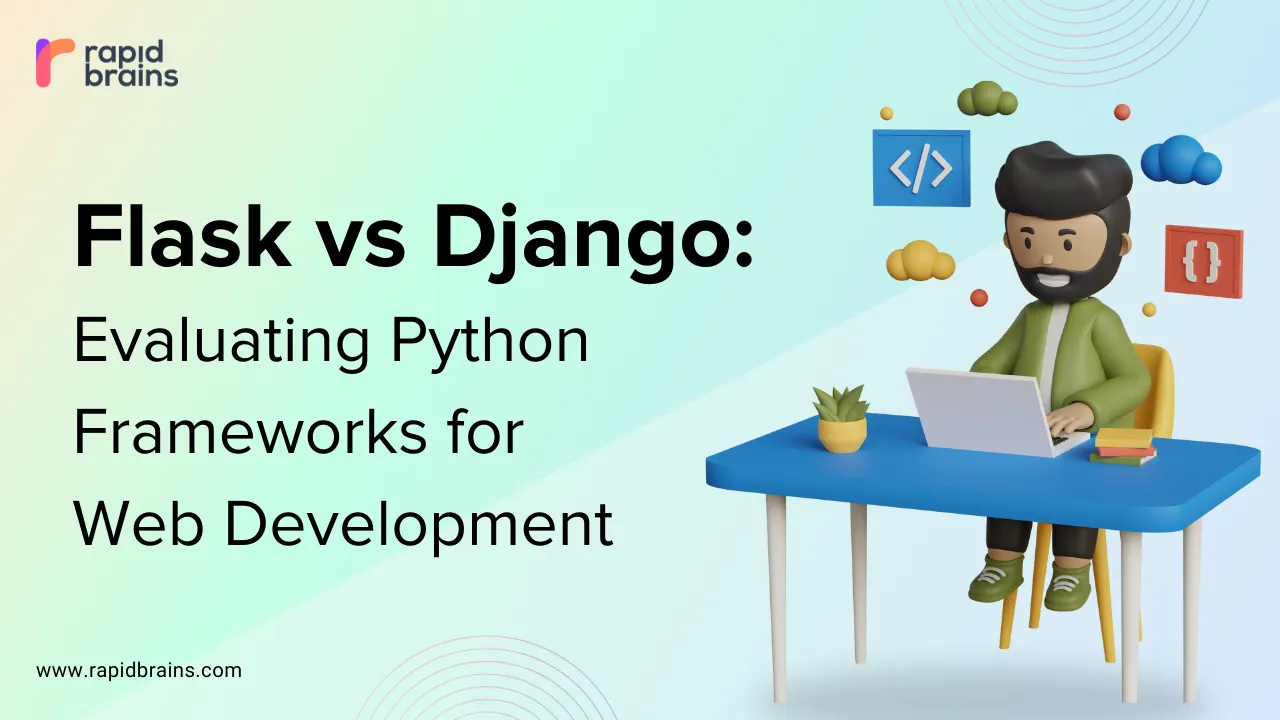
Introduction:
In the realm of Python web development, two popular frameworks stand out: Flask and Django. Both frameworks have their own strengths and are widely used for building web applications. This blog post aims to provide a detailed comparison of Flask and Django, focusing on their features, uses, user-friendliness, scalability, performance, flexibility, and security. By understanding the nuances of these python frameworks, developers can make informed decisions when choosing the right one for their projects.
What Is Flask?
Flask is a lightweight and minimalist web framework written in Python. It provides a simple and easy-to-understand interface for building web applications. Flask follows a “micro” approach, which means it has a minimalistic core and allows developers to add functionalities through its modular design. It does not come bundled with specific libraries or tools, offering developers the flexibility to choose the components they need.
Features of Flask:
1. Routing: Flask provides a routing mechanism to map URLs to specific functions, making it easy to define the application’s behavior.
2. Templating: Flask supports Jinja2 templating engine, enabling developers to generate dynamic HTML pages.
3. Flask extensions: Flask has a vast ecosystem of extensions that can be easily integrated to add various functionalities like database integration, authentication, and more.
4. Lightweight: Being minimalist, Flask has a small footprint and requires fewer resources, making it suitable for small to medium-sized projects.
5. Flexibility: Flask’s modular design allows developers to customize and extend its functionality according to the project requirements.
Uses of Flask:
1. Building small to medium-sized web applications.
2. Prototyping and developing minimal viable products (MVPs).
3. RESTful API development.
4. Creating lightweight and fast microservices.
5. Developing single-page applications (SPAs).
What Is Django?
Django is a high-level web framework built in Python. It follows the “batteries included” principle, which means it comes with a comprehensive set of tools and libraries out-of-the-box. Django’s philosophy revolves around DRY (Don’t Repeat Yourself) and promotes reusability and rapid development.
Features of Django:
1. ORM (Object-Relational Mapping): Django includes a powerful ORM that allows developers to interact with the database using Python objects.
2. Admin interface: Django provides an automatic admin interface that can be easily customized, making it convenient for managing content.
3. Authentication and authorization: Django has built-in user authentication and authorization mechanisms, providing secure access control to web applications.
4. Templating: Django offers its own template engine, which is feature-rich and allows for reusable templates.
5. Scalability: Django’s design principles and built-in tools enable developers to build scalable applications effortlessly.
Uses of Django:
1. Developing large and complex web applications.
2. Content management systems (CMS).
3. E-commerce platforms.
4. Data-driven applications with complex data models.
5. Geographical information systems (GIS).
When to Use Flask vs. Django:
Flask is suitable for smaller projects or when you need more flexibility to choose the components and libraries you want to use. It’s ideal for lightweight applications, APIs, and prototypes. On the other hand, Django shines in larger projects that require a comprehensive set of features, such as user authentication, admin interface, and database integration. Django’s batteries-included approach makes it well-suited for complex applications and projects with specific requirements.
Flask vs. Django User-Friendliness:
Flask and Django are two popular frameworks in Python used for web development. When it comes to user-friendliness, there are distinct differences between the two. Flask is known for its simplicity and minimalistic approach, providing developers with more flexibility and control over their code. It allows developers to start small and add only the necessary components, making it easy to understand and customize. On the other hand, Django follows a batteries-included philosophy, offering a comprehensive set of features out of the box. This can be advantageous for developers who prefer a more opinionated framework with built-in functionalities for common web development tasks. Django’s robustness and conventions can make it easier for beginners to get started, but it may require more effort to modify or adapt for specific requirements. Ultimately, the choice between Flask and Django depends on the developer’s preferences and the project’s needs.
Flask vs. Django Scalability:
Both Flask and Django are scalable frameworks, but Django provides better support for scaling applications. Django’s built-in tools and design principles promote scalability, making it a popular choice for large-scale applications.
In terms of scalability, Django is often considered more suitable for large-scale applications and complex projects. Its built-in features and conventions streamline the development process and provide a solid foundation for scaling. However, Flask’s flexibility allows developers to tailor the application architecture to specific scalability requirements, which can be advantageous in certain scenarios.
Ultimately, the choice between Flask and Django for scalability depends on the specific needs of the project. If you anticipate the need for rapid development and scalability out-of-the-box, Django may be a better choice. On the other hand, if you prefer a more lightweight and flexible framework that allows for more fine-grained control over scalability, Flask can be a good option.
Flask vs. Django Performance:
Flask has an advantage in terms of performance due to its lightweight nature. It has a smaller overhead and is generally faster than Django. However, the performance difference might not be significant unless dealing with extremely high loads or specialized use cases.Ultimately, the performance of Flask and Django depends on various factors, including the specific requirements of your application, the skillset of your development team, and the optimizations implemented. Flask’s minimalistic approach and flexibility provide more control over performance optimization, while Django’s extensive built-in features can make development more efficient but may introduce some overhead. It’s recommended to benchmark and profile your application to identify any performance bottlenecks and optimize accordingly.
Flask vs. Django Flexibility:
Flask, being a micro-framework, provides a minimalistic and lightweight structure. It offers great flexibility, allowing developers to have fine-grained control over their application. Flask lets you choose the components you want to include and gives you the freedom to build the application according to your specific needs. This flexibility makes Flask a popular choice for small to medium-sized projects or when you want to have complete control over the application’s architecture.
On the other hand, Django is a full-featured framework that follows the “batteries included” philosophy. It provides a robust set of tools, libraries, and predefined conventions, which makes it an excellent choice for rapid development and larger-scale projects. Django offers a more opinionated approach, promoting best practices and a standardized project structure. While this can limit flexibility in some cases, it also provides a solid foundation and accelerates development by handling common tasks, such as routing, database interactions, and user authentication, out of the box.
Flask vs. Django Security:
- Authentication and Authorization:
- Django provides a robust authentication and authorization system out of the box. It includes features like user authentication, password management, permission management, and built-in protection against common vulnerabilities like cross-site scripting (XSS) and cross-site request forgery (CSRF).
- Flask, on the other hand, is more lightweight and flexible, allowing developers to choose from a variety of authentication and authorization libraries. While Flask itself doesn’t provide a built-in system, it offers extensions like Flask-Login and Flask-Security that can be integrated for these purposes.
- Form Validation:
- Django provides a form validation system that helps protect against common security vulnerabilities such as SQL injection and cross-site scripting. It performs automatic validation of form inputs and provides convenient methods to sanitize and validate user data.
- Flask doesn’t have a built-in form validation system. Developers need to implement validation and sanitization mechanisms manually or by using third-party libraries like WTForms to ensure the security of form inputs.
- Security Updates:
- Both Flask and Django have active communities that regularly release security updates and patches to address any reported vulnerabilities. It’s crucial to keep your framework version up to date to benefit from the latest security enhancements.
- Community and Documentation:
- Django has a larger community and extensive documentation, making it easier to find resources and guidance on security best practices. The framework’s security features are well-documented, and there are numerous online discussions and tutorials available.
- Flask has a smaller but still active community. Although the documentation is not as extensive as Django’s, it is still comprehensive and covers security-related topics.
- Development Approach:
- Django follows the “batteries included” approach, providing many built-in features and security measures by default. This can be advantageous for developers who prefer a framework that handles security choices for them.
- Flask follows a “micro” approach, providing a minimalistic core and allowing developers to choose and integrate specific libraries and components as per their requirements. While this gives more flexibility, it also places the responsibility of implementing security measures on the developer.
Conclusion:
In conclusion, Flask and Django are both powerful Python frameworks for web development, each with its own strengths and use cases. Flask is lightweight, flexible, and ideal for small to medium-sized projects, while Django is feature-rich, scalable, and well-suited for larger and complex applications. When choosing between Flask and Django, consider the project requirements, complexity, scalability needs, and your familiarity with the frameworks. Both frameworks have thriving communities and extensive documentation, making them reliable choices for Python web development.





Lynette
September 28, 2023It’s really a nice and useful piece of info. I’m happy that you
simply shared this helpful info with us. Please keep us informed like this.
Thank you for sharing.
my site; gnux.info